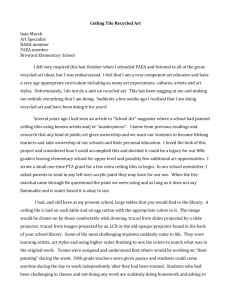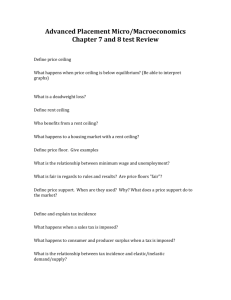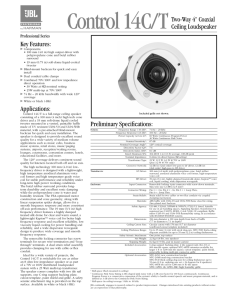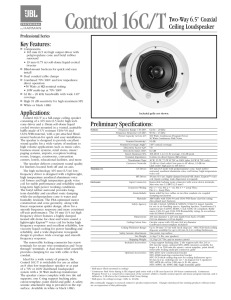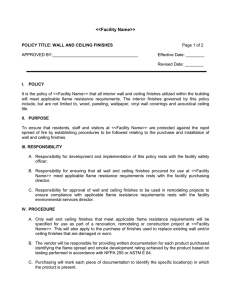Improving Classroom Acoustics handout
advertisement
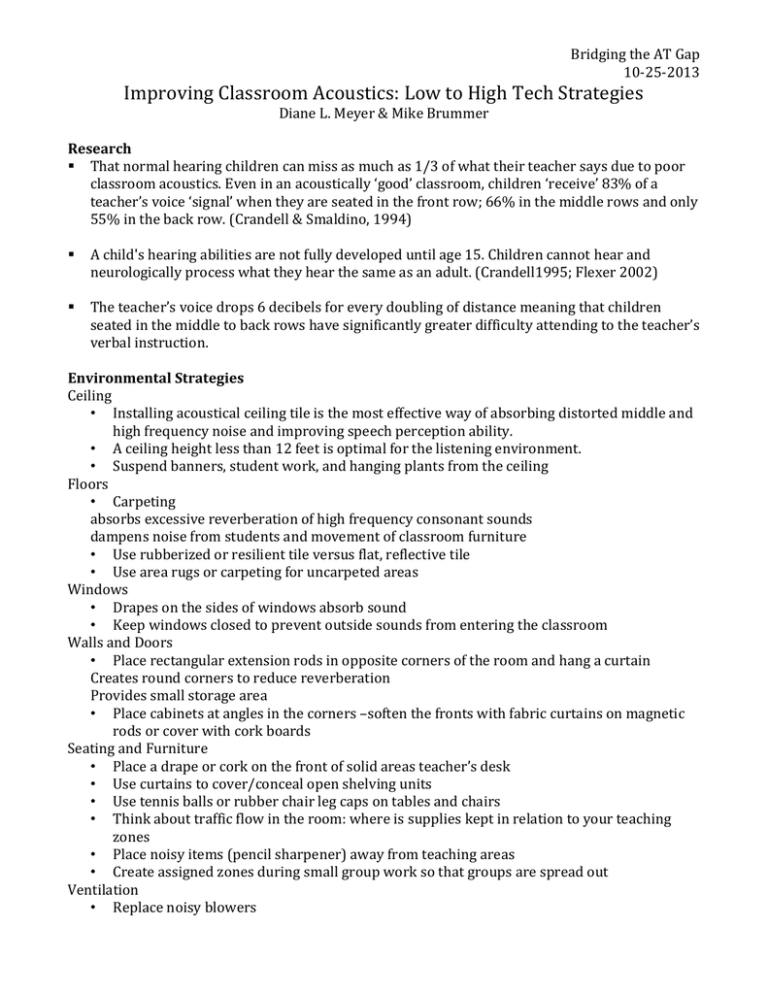
Bridging the AT Gap 10-25-2013 Improving Classroom Acoustics: Low to High Tech Strategies Diane L. Meyer & Mike Brummer Research That normal hearing children can miss as much as 1/3 of what their teacher says due to poor classroom acoustics. Even in an acoustically ‘good’ classroom, children ‘receive’ 83% of a teacher’s voice ‘signal’ when they are seated in the front row; 66% in the middle rows and only 55% in the back row. (Crandell & Smaldino, 1994) A child's hearing abilities are not fully developed until age 15. Children cannot hear and neurologically process what they hear the same as an adult. (Crandell1995; Flexer 2002) The teacher’s voice drops 6 decibels for every doubling of distance meaning that children seated in the middle to back rows have significantly greater difficulty attending to the teacher’s verbal instruction. Environmental Strategies Ceiling • Installing acoustical ceiling tile is the most effective way of absorbing distorted middle and high frequency noise and improving speech perception ability. • A ceiling height less than 12 feet is optimal for the listening environment. • Suspend banners, student work, and hanging plants from the ceiling Floors • Carpeting absorbs excessive reverberation of high frequency consonant sounds dampens noise from students and movement of classroom furniture • Use rubberized or resilient tile versus flat, reflective tile • Use area rugs or carpeting for uncarpeted areas Windows • Drapes on the sides of windows absorb sound • Keep windows closed to prevent outside sounds from entering the classroom Walls and Doors • Place rectangular extension rods in opposite corners of the room and hang a curtain Creates round corners to reduce reverberation Provides small storage area • Place cabinets at angles in the corners –soften the fronts with fabric curtains on magnetic rods or cover with cork boards Seating and Furniture • Place a drape or cork on the front of solid areas teacher’s desk • Use curtains to cover/conceal open shelving units • Use tennis balls or rubber chair leg caps on tables and chairs • Think about traffic flow in the room: where is supplies kept in relation to your teaching zones • Place noisy items (pencil sharpener) away from teaching areas • Create assigned zones during small group work so that groups are spread out Ventilation • Replace noisy blowers Bridging the AT Gap 10-25-2013 • Cover ventilation openings with strips of material • Do not use desk or floor fans Lighting • Make sure florescent lights are functioning correctly Ballast will make high frequency sounds when they begin to burn out • If your room is equipped with a motion sensor, position students with hearing aids out of the directional path of the doorway Special Purpose Areas • Carpeting • Use rubberized or resilient tile versus flat, reflective tile • Hang banners or flags from the ceiling • Place material or cloth banners on the walls Instructional Strategies Rate of Speech Immature central nervous system needs a slower rate of speech in order to process the acoustic linguistic code PK to 3rd grade need 120 words/minute 4th grade can process 124 to 128 words /minute Middle school can process 135 words per minute High school can process 145 words per minute Model a Preschool or Kindergarten teacher rate Repeating of peers’ questions, comments, answers Inverse Square Law – signal decreases 6 dB every time distance doubles Students 20 feet from speaker will function like a person with a mild hearing loss Repeat/Rephrase/Summarize all verbal communications Control competing background noise Close doors Turn off radios Use headphones for computer centers Face students when speaking Address the students when instructing Speech signal travels through the air to the students’ ears versus traveling to the board reflecting off the board Allows students to access the speaker’s face for any visual support Talk at a normal volume level Increasing the volume increases the distortion of the auditory signal Increasing the volume alters how you produce speech sounds making it difficult to speechread Technological Solutions Soundfield Systems • Surround sound systems for teachers and students • Group or classroom systems for instruction of large audiences • Personal systems for individuals with hearing loss • Can be wired or portable




